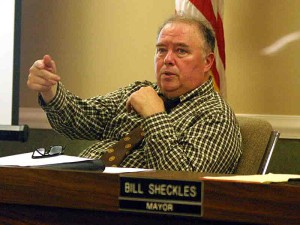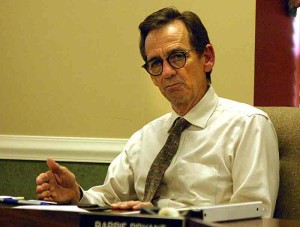Bardstown committee reviews issues in update of city’s sign ordinance
By JIM BROOKS
Nelson County Gazette / WBRT Radio

Councilman Tommy Reed gestures while discussing the goals of revisions to the city’s sign ordinance.
Saturday, Aug. 30, 2014, 5 p.m. — The committee that is charged with making updates to the City of Bardstown’s sign ordinance reviewed the existing ordinance and identified the rules that are working and those that needed to be addressed.
Janet Johnston-Crowe, planning administrator, and Larry Green, assistant city administrator, narrated a slide show that illustrated some of the existing signage issues the committee may wish to address.
Temporary signs — inside and outside the historic district — are one of the biggest enforcement headaches, Johnston-Crowe told the committee.
Temporary signs include A-frame type signs, banners, streamers, balloons, etc. According to the existing city sign ordinance, temporary signs can only be used four weeks in a calendar year. Temporary signs require a permit.
The original intent of regulating temporary signs was to discourage clutter, she explained.
In the city’s historic district, the city’s temporary sign regulations do not apply; the Historic Review Board (HRB) has jurisdiction of temporary signs. However, Johnston-Crowe noted that neither the HRB nor the planning commission have jurisdiction over signs placed on downtown sidewalks, like A-frame signs. The city has a separate ordinance that addresses sidewalk signs and tables regarding placement and keeping room for pedestrian traffic.

Larry Green, assistant city administrator, gives the committee some history of the sign ordinance and why it was created as a standalone ordinance.
She noted the committee needs to understand that her office has no jurisdiction over the sidewalk or the separate city ordinance (regarding sidewalk displays), and the ordinance needs to address that as a new area to regulate. Another option is to allow businesses with sidewalks to have a temporary sign — like an A-frame sign — without requiring a permit, she said. In the county, businesses are allowed to have one temporary sign at all times, she explained.
The discussion of signage goes back to the original 1994 ordinance discussion, Larry Green, assistant city administrator explained.
“You have to look at the purpose of signs in the ordinance, which is to allow the traveling public to locate a particular business,” he said. It’s also necessary to identify between identifying signs and advertising signs that promote a specific service or product, he said.
Signs that advertise a specific product give that business an advantage over the businesses that follow the rules, Reed explained, adding that the sign ordinance tries to give all businesses fairness and a level playing field.
PENNANT PROBLEM. The popular “OPEN” pennants used by downtown businesses are technically not allowed by the existing ordinance, Johnston-Crowe advised. The pennants are a hold-over from the Main Street project when sidewalks downtown were torn up during construction.
The signs were allowed during the project and were intended to be temporary, Councilman Tommy Reed explained. “They just never quit being temporary.”
Samantha Brady, the director of downtown development for the Bardstown Main Street program, said the banners are very popular with downtown businesses.
“Most of the businesses I talk to believe the sign makes a difference,” Brady said. Businesses outside the downtown district often tell her they would wish they had them too, she told the committee.
Green noted the pennants are looking faded and ragged. “We spent several million dollars on Streetscape to get downtown to look ‘just so,’ ” Green said. “To me (the banners) add clutter, they make it look ugly and take away from the architecture.”
Green said the question the committee must ask is “What do we want downtown to look like?”
“It’s not just the opinion of the business owners that matter,” Green said.
Removing the open pennants would mean no business would have an advantage over another one, Reed said.
SIGNS, SIGNS, EVERYWHERE A SIGN. Green and Johnston-Crowe reviewed other signs that have shown up but are not directly addressed by the sign ordinance. These include landscape as signage, the addition of signage to restaurant drive-through menu boards, gas pumps, grocery store cart return racks and ice vending machines.
“Does it really matter to you all, or is it a fairness issue?” Johnston-Crowe asked. “Just food for thought.”
The popularity of “wrapped” vehicles raise questions about their role as signs or advertising, she said. Are wrapped vehicles parked in prominently public areas serving as advertising? Similar questions arise about the role of trailers bearing business signs and logos. “Enforcement would be much easier if definitions were tighter,” Crowe said.
ENFORCEMENT. Enforcing the city sign ordinance is an issue the committee needs to consider, Johnston-Crowe said. Her office doesn’t have resources to pursue all of the sign ordinance violations, so minor violations aren’t currently always addressed.
“It would be easier to simplify the ordinance and let some things go,” Johnston-Crowe said. “That way it’s fair to everyone and it’s no longer an enforcement issue.”
Charles Howard, the vice-chair of the Joint City-County Planning Commission, voiced his concern over the plan to move the city’s revised ordinance back to the county’s zoning regulations.
Once the revisions are completed, the ordinance would basically be forced on the planning commission to deal with, Howard told the committee. The council — which approves the ordinance — would then no longer be required to hear appeals of the their own ordinance. Appeals of the ordinance would go to the city’s Board of Adjustments and require a $208 filing fee.
The move would mean the council would no longer be held accountable for the rules it makes, Howard said. If the council is making the new sign regulations, the council should be responsible for defending appeals of those rules.
“I don’t see how this fits in with planning and zoning,” Howard told the committee. “I don’t think we have the staff for it.”
The only real difference is the appeals process, Johnston-Crowe explained. “The appeal is in front of a five-member citizen body rather than an elected body,” she said.
“I’m not interested in the planning commission becoming the whipping boy for the city council, or for the council to point fingers at and say ‘It’s all their fault,’ ” Howard said. “I just have a trouble saddling the planning and zoning commission with a cumbersome set of regulations we have no prayer of being able to enforce.”
Commission attorney Michael Coen said enforcement of a revised ordinance will be easier if the language is very clear and specific.
“In regard to the ordinance, simple is good, but clear is better,” he said. “The ordinance should say it in plain English and be specific in its terms.”
NEXT. The sign committee will meet again at 4 p.m. on Wednesday, Sept. 10.
-30-






